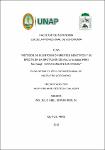| dc.contributor.advisor | Soplín Ríos, Julio Abel | |
| dc.contributor.author | Reátegui Salazar, Andy Richard | |
| dc.date.accessioned | 2021-09-10T12:27:41Z | |
| dc.date.available | 2021-09-10T12:27:41Z | |
| dc.date.issued | 2012 | |
| dc.identifier.uri | https://hdl.handle.net/20.500.12737/7463 | |
| dc.description.abstract | En la presente investigación se buscó Determinar el efecto del genotipo y el método
de injerto en la brotación del injerto en Myrciaria dubia (H.B.K) Mc Vaugh “camu
camu”. La distribución de los tratamientos en el campo se realizó con un Diseño de
Bloques Completos al Azar con arreglo factorial de 3 x 3 con 4 repeticiones. Para la
toma de muestra se consideraron todas las plantas. Al existir 36 unidades
experimentales distribuidas en los 4 bloques y cada una con 10 plantas, se evaluaron
un total de 360 plantas. Se realizaron tres (3) evaluaciones; a los 75, 90 y 105 días
después de realizado el injerto. Se evaluó las variables de Porcentaje de Brotación
del Injerto, Número de brotes del injerto, Longitud de brote del injerto, Número de
hojas/brote del injerto.
De la evaluación de las variables en estudio se concluye que: En el Porcentaje de
brotación del injerto, se encontró que el método de injerto por púa (m3), presenta
mayor efecto en la soldadura del injerto con promedio de 85% de brotación. En lo
concerniente al Número de brotes del injerto, se encontró que el método de injerto
por púa (m3), con promedio de 3.04 brotes, es superior a los métodos de injerto por
astilla doble (m2) e injerto por astilla simple (m1). En lo relacionado a la Longitud del
brote del injerto, con el método de injerto por púa (m3) se logró mayor efecto sobre
la longitud de brote, con promedio de 13.77 cm, superando estadísticamente a los
métodos de injerto por astilla simple (m1) e injerto por astilla doble (m2). En lo
concerniente al Número de hojas por brote del injerto, con el método de injerto por
púa (m3) se logró mayor efecto sobre el número de hojas/brote con un promedio de
11.52 hojas/brote, superando significativamente a los métodos de injerto por astilla
simple (m1) e injerto por astilla doble (m2). | es_PE |
| dc.description.abstract | In the present investigation we sought to determine the effect of the genotype and the
grafting method on the budding of the graft in Myrciaria dubia (H.B.K) Mc Vaugh
“camu camu”. The distribution of the treatments in the field was carried out with a
Random Complete Block Design with a factorial arrangement of 3 x 3 with 4
repetitions. All plants were considered for sampling. As there were 36 experimental
units distributed in the 4 blocks and each one with 10 plants, a total of 360 plants were
evaluated. Three (3) evaluations were carried out; at 75, 90 and 105 days after the
graft was performed. The variables of Graft Sprouting Percentage, Number of graft
sprouts, Graft sprout length, Number of leaves / graft sprout were evaluated.
From the evaluation of the variables under study, it is concluded that: In the
percentage of budding of the graft, it was found that the grafting method by spike
(m3), presents a greater effect on the welding of the graft with an average of 85% of
budding. Regarding the number of shoots of the graft, it was found that the grafting
method per spike (m3), with an average of 3.04 shoots, is superior to the grafting
methods per double splinter (m2) and grafting per single splinter (m1) . Regarding the
length of the graft shoot, with the spike graft method (m3) a greater effect was
achieved on the shoot length, with an average of 13.77 cm, statistically surpassing
the simple splinter grafting methods (m1). and double splinter graft (m2). Regarding
the Number of leaves per bud of the graft, with the grafting method per prong (m3) a
greater effect was achieved on the number of leaves / bud with an average of 11.52
leaves / bud, significantly surpassing the grafting methods by single splinter (m1) and
double splinter graft (m2). | es_PE |
| dc.format | application/pdf | es_PE |
| dc.language.iso | spa | es_PE |
| dc.publisher | Universidad Nacional de la Amazonía Peruana | es_PE |
| dc.rights | info:eu-repo/semantics/openAccess | es_PE |
| dc.rights.uri | https://creativecommons.org/licenses/by/4.0/ | es_PE |
| dc.subject | Injerto de yema | es_PE |
| dc.subject | Genotipos | es_PE |
| dc.subject | Brotación | es_PE |
| dc.subject | Camu camu | es_PE |
| dc.subject | Myrciaria dubia | es_PE |
| dc.title | Métodos de injerto en diferentes genotipos y su efecto en la brotación de Myrciaria dubia (HBK) Mc Vaugh, camu camu en San Miguel | es_PE |
| dc.type | info:eu-repo/semantics/bachelorThesis | es_PE |
| thesis.degree.discipline | Agronomía | es_PE |
| thesis.degree.grantor | Universidad Nacional de la Amazonía Peruana. Facultad de Agronomía | es_PE |
| thesis.degree.name | Ingeniero(a) Agrónomo | es_PE |
| dc.subject.ocde | http://purl.org/pe-repo/ocde/ford#4.01.06 | es_PE |
| renati.author.dni | 46603898 | |
| renati.advisor.orcid | https://orcid.org/0000-0002-5496-2673 | es_PE |
| renati.advisor.dni | 05226141 | |
| renati.type | http://purl.org/pe-repo/renati/type#tesis | es_PE |
| renati.discipline | 811036 | es_PE |
| renati.level | http://purl.org/pe-repo/renati/level#tituloProfesional | es_PE |
| renati.juror | Ramírez Chung, José Francisco | |
| renati.juror | Vásquez Matute, Armando | |
| renati.juror | Pérez Marín, Miguel Arístides | |
| dc.publisher.country | PE | es_PE |


